Posted by Elena del Valle on November 20, 2019
By Gabriela Lechin
Senior vice president
Global Results Communications

Gabriela Lechin, senior vice president, Global Results Communications
Photo: Global Results Communications
Despite accounting for less than 20 percent of the United States population, Hispanics accounted for 82 percent of the United States labor-force growth participation between the years 2010 and 2017. Gross Domestic Product (GDP) among Hispanics in America grew at a faster rate than the overall United States economy during this time, increasing from $1.7 trillion in 2010 to $2.3 trillion in 2017, according to the 2019 LDC U.S. Latino GDP Report by the California Lutheran University, making it the third-highest growth rate among all global economies during that period on a compounded annual basis. Some of the main influences powering this performance are Hispanics healthy growth in population, their increasing consumer spending and high labor-force participation. According to the report, the financial contribution of the Hispanic community in America will become progressively significant in the upcoming years of the country’s economy.
Click to read the entire Guest Article by Gabriela Lechin: Finding the silver lining in cultural appropriation
Posted by Elena del Valle on November 12, 2019

2019 Los Cabos International Film Festival poster
Image: Los Cabos International Film Festival
The organizers of the 2019 Los Cabos International Film Festival in Los Cabos, Baja California Sur, Mexico hope to draw more than 13,300 attendees, 30 percent of them from the United States, to their event to be held at the Cultural Pavilion in Cabo San Lucas November 13-17, 2019. Attendees are expected to be film industry executives from Mexico, United States, Canada, Europe, South America and Asia, including filmmakers, actors, producers, sales agents, film programmers, film critics, government and cultural authorities, as well as local and foreign film fans.
Some 42 films are expected to participate in the event. Los Cabos Arte y Cultura, the nonprofit organization behind the festival, is headed by Alfonso Pasquel Bárcenas, according to a spokesperson for an area property.
According to a press release the festival was founded in 2012 by Scott Cross, Sean Cross, Eduardo Sanchez-Navarro Redo, Alfonso Pasquel, Juan Gallardo Thurlow, Eduardo Sánchez-Navarro Rivera Torres, and Pablo Sanchez-Navarro. The annual event was created to foster exposure for the “Mexican film industry and it’s up and coming filmmakers.” A list of films and show times is available on the bilingual festival website, cabosfilmfestival.com
Posted by Elena del Valle on November 6, 2019
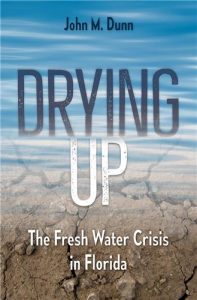
Drying Up
Photos: John Dunn, Susan Dunn
Florida is approaching a crisis. The peninsula surrounded by water on three sides and with more coastal miles than any continental state save Alaska may not have enough water to serve the needs of existing residents, new residents and tens of millions of visitors in the coming years. While water issues are not new they have grown worse, according to John Dunn, author of Drying Up: The Fresh Water Crisis in Florida (University Press of Florida, $24.95).
Drawing on more than one hundred interviews and years of research he points out that pollution, failing infrastructure, increasing outbreaks of toxic algae blooms, and pharmaceutical contamination are worsening water quality. Climate change, sea level rise, and groundwater pumping are spoiling freshwater resources with saltwater intrusion. Shortages have prompted fights over rights to the Apalachicola River, Lake Okeechobee, and the Everglades among other important watersheds.
Population growth is accelerating a difficult situation, he says. In the not too distant future water scarcity may force municipalities to offer residents toilet-to-table “reused water.” In the book, he outlines the history of water in the Sunshine State and some of the most salient fresh water concerns.
“I am a native Floridian, veteran freelance writer, teacher, and environmental activist,” the author replied by email when asked what prompted him to write the book now. “With these perspectives it hasn’t been hard for me to detect the degradation of our water resources over the years. They aren’t new. They are only growing worse. A friend of mine Cynthia Barnett, a former staffer with Florida Trend Magazine, caught the attention of many Floridans about a decade ago with her book, Mirage. Unfortunately, there has been little improvement addressing our water issues.
I originally queried the editorial staff of the University Press of Florida (UPF), wanting to write a Florida-specific book on climate change. UPF already had such a book in production. But the editor asked me if I’d like to write a different one on Florida’s water woes instead. I’d written on water issues for magazines in the past. In addition, I’d worked with various conservation groups. So, I had a background in water issues and experience which I could draw on. I submitted up a book outline and got a contract.”
From idea to publication the hardcover book took Dunn two and a half years to complete. He wrote for general readers, relying on a magazine style of writing to make it reader friendly. The book struck a cord because he has received many invitations for book presentations across the state, including the Miami Book Fair this month.
“During the Q&A at these presentations, I’ve noticed that many people, especially those that have recently moved here, are either surprised or shocked to realize how impaired our waters are,” he said.
How soon should we expect the toilet-to-table water stage in Florida? “Experts told me it will be at least a decade from now, if that soon, before many Floridians are able to get over the ‘yuk’ factor associated with drinking recycled or ‘reuse’ water. One way of reusing waste water is the indirect method. This is the what many people in Tampa would like to explore; that is, pumping treated wastewater deep into the ground beneath the ‘shallower aquifer’ (from which we extract drinking water). There, presumably, the sunken, treated water will mix with existing ground water and get an extra dose of filtration as it moves through the subterranean world before it is extracted topside as drinking water.
The other method is to treat wastewater with advanced methods and then pipe it directly to a facility where it is blended with the utility’s water supply. Astronauts use this method in outer space when they treat and recycle their own urine. The people of Singapore, facing critical water shortages, now drink this direct potable ‘reuse’ water, which they call NEWater.”
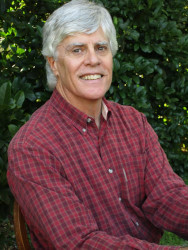
John Dunn, author, Drying Up
When asked what he would like to accomplish from writing the book he said, “I hope my book provides a ‘primer’ for readers which will give them the confidence to become citizen water activists. Anyone contemplating a move here, especially those hoping to do business in the state, should investigate both the availability and reliability of water supplies.They also need to evaluate the impact their own possible arrival could make on Florida water. Americans are used to thinking about their ‘Carbon Footprint.’ Increasingly here in Florida and the world, people are realizing they must also now calculate their ‘Water Footprint.’
As I’ve explained in Drying Up, Central Florida is already drawing water faster from the ground than it is being recharged by rainfall. South Florida is not far behind in being in the same situation.”
What can Florida residents do to secure clean water in the coming decade? “The biggest problem to Florida’s water supply is our growing population, along with public indifference and the current ‘business as usual’ approach to economic activity,” the author said. “For too long, the Florida Growth Machine, developers, bankers, realtors, and their compliant political allies, have viewed Florida as a commodity, a place to be consumed for a profit. Currently, the Miam/Dade (Miami/Dade) County Commission is paving the way for construction of the largest mall in the country. The $4 billion retail and entertainment complex will be built on the edge of the Everglades. It will even provide artificial snow so shoppers can ski. This, in a subtropical setting that will face water shortages in the near future! Such insanity runs rampant in our state.
In my lifetime, I’ve seen Florida’s population jump from 2 million to 22 million. We now receive over 120 million tourists annually. The 1000 Friends of Florida 2017 study suggests that if present demographic trends continue, Florida could add another 15 million by 2070. By then, much of the state is likely to be swamped by sea level rise.
Floridians who worry about securing fresh water need to be mindful of the plight of their water supply right now. It’s amazing to me that the nation gets excited about spending billions of dollars looking for a drop of water on Mars or the moons of Saturn with the hope it could suggest the existence life, while simultaneously wasting fresh water on earth with abandon.
All of us are guilty of squandering water. Floridians use 50 percent of the state’s fresh water supply irrigating their lawns every day. Every time we flush a toilet and fertilize our yards we contribute to the ‘nutrient’ contamination of fresh water by fueling algae growth. Every time we soak our lawns with pesticides, we pollute groundwater. Every time we clear-cut Florida’s forests, wetlands, and natural vegetation, or dig canals, change the contour of the earth, and plaster the ground with asphalt and concrete, we cause the greatest damage of all to our fresh water supplies. That’s because we destroy Florida’s natural hydrologic systems. When we do this, we literally disrupt the natural evaporation, drainage and percolation of water to the aquifer.
Every day our fresh water is also being polluted from industry, storm water runoff, and aging sewage systems and water treatment plants. Meanwhile, climate change is causing extreme flooding, rising sea levels, and perhaps occasional periods of drought. All of these forces contaminate fresh water wells.
Finally, I think, Floridians need to adopt a more enlightened ‘Soft Path’ approach to water which I’ve described in the book. These means restoring wetlands and natural hydrologic systems, mimicking nature, and increasing the use of conservation and recycling. It calls for the water management districts to stop giving out new water pumping permits like library cards. It also means a shift in values. Water shouldn’t be a commodity. It is, after all, the unique, perhaps, divine substance that gives rise to life on earth.
Floridians must elect only those who also understand the natural world and will fight to protect our natural resources, not exploit them. Otherwise, developers, big business, fracking interests, and large-scale agriculture operations (ranging from the growing of sugar cane to raising cattle), will be the main water policy makers.
I hope my book will help bring about these goals.”
Dunn, a native of Miami, is a working freelance writer and journalist and a veteran high school history teacher. He has published over 350 articles for more than twenty periodicals as well as young adult books. A member of the Silver Springs Alliance, Dunn has worked for years with other volunteers to address many of Florida’s pressing environmental problems. He lives with his wife Susan in Ocala, Florida.

Minuscule commissions earned from Amazon. Links included mostly for reader convenience: Click to buy Drying Up
Comments:
Filed Under: Books
Posted by Elena del Valle on October 30, 2019

The Pollinators poster
Cinematographer Peter Nelson dedicated countless hours to filming bees, traveling to 14 states, following bee managers and their bees; and interviewing 26 people in the making of The Pollinators, a 92-minute film about bees and their role in agriculture today. Its festival premiere was at the Big Sky Documentary Film Festival. To date it has been screened at 18 festivals. He has already taken home seven festival awards. Scroll down to watch a trailer for The Pollinators*.
When asked by email what prompted him to make a film now he said, “I am a backyard beekeeper for over 30 years now and also a cinematographer by profession. I also have a great interest in food and agriculture and felt the story of migratory beekeepers and our dependence upon managed honey bees was not well known I was compelled to tell this story due to a collisions of all these passions.
Losses among commercial beekeepers are very high and range from 30 to 50 percent or more. This is not sustainable long term and this matters to all of us because us our dependence upon the managed bees for so much of our food. One of every three bites is something pollinated by a bee, so this is really important if you like to eat. We are in a time of peril for the bees (and also many other insects) and I wanted to take a look at this and tell this story.”
The target audience? Beekeepers, of course as well as people interested in the environment, farming, foodies and gardeners. The film includes bee close ups and beautiful images of the insects in flight as well as disturbing shots of thousands of dead bees.
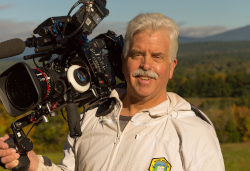
Peter Nelson, director, The Pollinators
“Filming bees was a challenge, but also a lot of fun,” the filmmaker said. “I wanted to try and show bees in a way I had not really seen before as the wonderful beautiful insects they are. Many people are afraid of bees and I understand that as they are a stinging insect. Unlike yellow jackets, honey bees will sting only as a last resort and they die in the process so honey bees are not aggressive for the most part. Honey bees are also incredibly beautiful and complex creatures and I wanted to try and show bees to audiences in a new way and share how wonderful and graceful honey bees really are. I used a lot of very high speed photography (up to 1560 frames per second) to show bees in super slow motion flying, taking off, landing and just being beautiful in their natural environment.
Bees fly really fast and so are very challenging to film, especially in macro close up. My experience as a beekeeper for many years, gave me an advantage with this by understanding a bit about bee behaviors and the way they fly, land and their rhythms to some extent. It also required a lot of patience and a steady hand to keep the bees in focus at such shallow depth of fields.
I used Vision Research Phantom cameras and macro lenses provided by AbelCine for the ultra slow motion. The specialty cameras were provided by AbelCine as part of a grant for this project. My main camera was a Canon c300 Mk II and a 17-120 cinema zoom which I own and also some prime lenses for night. I also cannibalized one of my backyard bee hives to be able to stick a lens right inside the hive for a unique view of the bees inside their homes.”
Regarding funding and support he said, “We have a tremendous amount of sweat equity and some personal funding in the film. Being a cinematographer, I could go shoot pretty much as I needed to so was able to respond quickly to developments and shoot as needed. We also had some early financial support from Burt’s Bees, The Schumann Media Center helped us with funding. We also won a Doc Pitch competition from the Paley Center.
AbelCine gave us an ‘in-kind’ grant towards specialty camera equipment and lenses. Michael Reuter, the editor, producer and co-owner of EditBar helped us tremendously in post production right through completion.”
The only people who were paid were crew members for their services, he said, and no one who appears in the film was compensated in any way for his or her appearance nor was anyone paid for access.
“I wanted to bring this important story to audiences, to try and connect people to their food, where it comes from and a bit of what is involved in growing it,” he said when asked what he hoped to accomplish. “I also wanted to raise awareness and try to explain some of the causes of pollinator decline. If we can connect dots for people about the role of pollinators to our food system in some way, I would consider that a success.”
The producers were Sally Roy, Peter Nelson and Michael Reuter. Nelson was director of photography. At the time of this writing the project leaders were starting a theatrical release through Demand.Film, a crowd sourced distribution platform designed to make films available to cinemas across the United States, Canada, Australia, New Zealand, United Kingdom, Ireland and Germany over the next months. The goal is for the film to screen in one day events across the country in many places that would not likely screen independent documentaries. A national day of screenings is planned for Nov 6, 2019 in the United States (more at //us.demand.film/the-pollinators/). Broadcast, streaming, video on demand (VOD) and educational distribution venues have not been determined yet.
*Photos, video: Poster image and video courtesy of Peter Nelson, photo of Peter Nelson courtesy of Eric Krieger
Posted by Elena del Valle on October 23, 2019
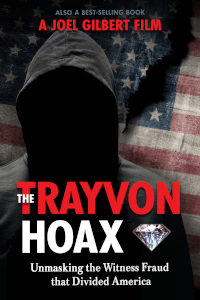
The Trayvon Hoax
Photos, video: Highway 61 Entertainment
Los Angeles based filmmaker Joel Gilbert set out to produce a documentary about the rise of Andrew Gillum, a past Florida gubernatorial candidate. He ended up writing a book and making a film about the death of Trayvon Martin and the trial of George Zimmerman in Sanford, Florida. The world premiere debut of The Trayvon Hoax: Unmasking the Witness Fraud that Divided America, a two-hour film, was at The National Press Club in Washington DC September 16, 2019. Scroll down to watch a video clip of the film.
When asked by email what prompted him to search this topic, write a book and make a film the director said, “I had followed the 2012 shooting death of seventeen-year-old Trayvon Martin and the subsequent trial of George Zimmerman from afar and, like many others, I had grave concerns about the lynch mob mentality that drove the case. Only after I started researching the project did I realize I had stumbled into the most spectacular case of identity fraud in modern American judicial history. The fraud resulted in the seminal race hoax of the Obama years. I call it ‘The Trayvon Hoax.’ It is appalling that six years after the Zimmerman trial so much information was left for me, an independent filmmaker, to discover. If the media had wanted to find the truth, it was there for the plucking. I was able to uncover it simply by reading publicly available information from the legal proceedings and following up on what I read. How is it possible no one in the media chose to do what I did? The answer is simple. The media did not want to know. The truth would not have advanced their fear-fueled racial agenda.
The Zimmerman trial literally divided America. Prior to the trial in 2012, both blacks and whites rated race relations as positive. This has been negative ever since. It lead directly to the ‘Ferguson Effect,’ a crime disaster for black neighborhoods with homicides up 33 percent. Also, the modern era of fake news and race hoaxes started with this case. Nothing has been more damaging to the United States than this trial and no one has suffered more from this ongoing hoax than the black youth of America.”
It took about 11 months to complete the film and book project, the author said. He dedicated the first five months to the investigation and filming. The next six months were for film editing and writing the 272-page book. He declined to disclose the budget or the source of funding for his project, saying, “We are a private independent film production company and we don’t disclose our budgets related to any project. However, there was no third party funding or donations for this film.”
“This Trayvon Martin shooting and Zimmerman case is still talked about and on everyone’s mind,” the filmmaker said when asked why he thinks the topic is relevant today, years after the trial took place. “Its why Black Lives Matter was formed. Presidential candidate Kamala Harris recently tweeted that Trayvon Martin started a movement. Well, that movement led to massive racial division and harm in America, all because of a fake witness. All the fake news and race hoaxes that continue to this day started with the Zimmerman trial, it was ground zero. Also, Sybrina Fulton, Trayvon Martin’s mother, is running for Miami-Dade Commissioner. The film provides evidence that Ms. Fulton knew about the fake witness in the case, but allowed it to go forward anyway. She did not alert the media or the judge even though she knew Rachel Jeantel was not Diamond Eugene as she claimed to be. Ms. Fulton was just endorsed by Hillary Clinton on Twitter who asked her 25 million followers to contribute to her campaign. Corey Booker endorsed her as well. I have no doubt that the Democrats are planning to bring Ms. Fulton to the Democrat convention once again in 2020 to help push their race based narratives of ‘black-men-are-targeted-by-racist-whites and cops’ to try to secure 95 percent of the black vote.”
When asked if he compensated Zimmerman (or anyone else) in any way for the on camera interview he replied, “As is customary for interviews with public figures who are featured in documentaries in extended interviews, Zimmerman was paid an appearance fee for his time. Zimmerman did not testify in his own trial, so The Trayvon Hoax: Unmasking the Witness Fraud that Divided America provides his account for the first time.”

Joel Gilbert in a scene from the film
To the question “Did you reach out to the teenager’s family, Zimmerman’s attorney, the prosecutor, witnesses such as Martin’s girlfriend who testified or anyone involved with the case (other than Zimmerman’s on camera interviews) to ask for their comments on your findings?” he replied, “I reached out to Zimmerman’s attorneys early on and got some help with background questions mostly. Mark O’Mara initially expressed skepticism that Rachel Jeantel was a fraud. “She was such a terrible witness,” he told me rhetorically, “why would anyone use her as a substitute?” I explained to O’Mara that those who knew the depth of the evidence exonerating George, his broken nose, his recorded screams for help, Johnathan Good’s testimony, never expected to get a conviction. Nothing any fake witness could say could overcome the hard evidence, I told him. But then again conviction was never the point; an arrest was what mattered. For Crump, an arrest opened the door to a civil suit. For the State of Florida, an arrest kept the mob at bay. For Barack Obama’s Justice Department, an arrest meant getting out the black vote for Obama in 2012 in Florida and hopefully nationwide. For Al Sharpton and his crowd of Leftists, an arrest and trial advanced their racially charged agenda.”
The film and book are available online at Amazon.com and other websites that sell DVDs, books and eBooks. The film is available as a DVD and for live streaming on demand on Vimeo.com.
“I hope that by exposing the truth about this major legal case that divided America based on a fraudulent witness, that it might result ultimately in national healing,” he said when asked what he hoped to accomplish from the book and film. “America got played by an epic race hoax that divided us for no reason. Americans are all brothers. Black and white, we are all brothers. My hope is to show how politicians and the media used Trayvon Martin’s tragic death to tear us apart, when our true aspirations have always been to come together as one nation.”
According to his website biography Gilbert is president of Highway 61 Entertainment, a political commentator and foreign policy analyst. Other films listed to his credit include Dreams from My Real Father (2012), There’s No Place Like Utopia (2014), Trump The Art of the Insult (2018), Farewell Israel (2008) and Atomic Jihad (2010).
Posted by Elena del Valle on October 14, 2019
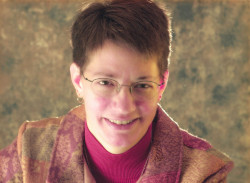
Michele Colopy, program director, Pollinator Stewardship Council
Photo: Michele Colopy
A podcast interview with Michele Colopy, program director, Pollinator Stewardship Council is available in the Podcast Section of Hispanic Marketing and Public Relations, HispanicMPR.com. During the podcast, she discusses honey and beekeeping with Elena del Valle, host of the HispanicMPR.com podcast.
Michele has held her current position since March 2013. Her father was a beekeeper in southeast Ohio. She keeps honey bees in the city, and has replaced her crabgrass front yard with pesticide-free pollinator flowers for her honey bees and native pollinators. Her nonprofit experience includes work in the performing arts, housing and homelessness, foreclosure prevention, community development, and health and wellness.
To listen to the interview, scroll down and click on the play button below or locate the “Podcast” section on the right hand side, then choose “HMPR Michele Colopy” or download the MP3 file to your iPod or MP3 player to listen on the go, in your car or at home from the RSS feed. Some software will not allow flash, which may be necessary for the podcast player. If that is your case, you will need to download the file to play it. To download it, click on the arrow of the recording you wish to copy and save it to disk. The podcast will remain listed in the October 2019 section of the podcast archive.
Posted by Elena del Valle on October 8, 2019
By Isabel Rafferty
CEO
Canela Media

Isabel Rafferty, CEO, Canela Media
Photo: Canela Media
In this age of social media and personal branding, people are more attuned than ever to the PR-speak, photo-shopped images and marketing tactics that brands engage in. As a result, audiences have shown an affinity towards those brands that present a more “authentic” version of themselves – that is to say, a version that takes a more active role in addressing real world issues and promoting diversity. As a result, many brands have looked to influencer marketing to bring them additional credibility. However, as consumers grow increasingly cynical not only of brands but of the influencers who peddle their products, brands have to find new ways – and new influencers – to increase trust.
Click to read the rest of Micro-Influencers Are the Future of Marketing
Posted by Elena del Valle on September 30, 2019

Tom McMakin, co-author, How Clients Buy
Photo: Carlie Auger
A podcast interview with Tom McMakin, co-author, How Clients Buy A Practical Guide to Business Development for Consulting and Professional Services (see Executives discuss how clients buy services) is available in the Podcast Section of Hispanic Marketing and Public Relations, HispanicMPR.com. During the podcast, he discusses how clients buy professional services with Elena del Valle, host of the HispanicMPR.com podcast.
Tom is chief executive officer and partner of Profitable Ideas Exchange (PIE). Before joining PIE, he was co-founder and managing director, Orchard Holdings Group, a private equity firm based in Cincinnati, Ohio. He also served as an operating affiliate at McCown DeLeeuw and TSG Consumer, two consumer-focused buyout groups in San Francisco. Prior to working in private equity, he was the chief operating officer of Great Harvest Bread Co., a multi-unit operator of bread stores based in Dillon, Montana.
To listen to the interview, scroll down and click on the play button below or locate the “Podcast” section on the right hand side, then choose “HMPR Tom McMakin” or download the MP3 file to your iPod or MP3 player to listen on the go, in your car or at home from the RSS feed. Some software will not allow flash, which may be necessary for the podcast player. If that is your case, you will need to download the file to play it. To download it, click on the arrow of the recording you wish to copy and save it to disk. The podcast will remain listed in the September 2019 section of the podcast archive.
Posted by Elena del Valle on September 25, 2019
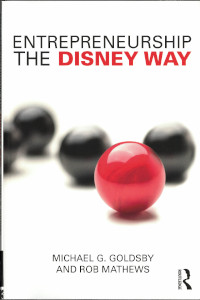
Entrepreneurship The Disney Way
Photos: Routledge, Zeller Photography, Ball State University
In Entrepreneurship the Disney Way (Routledge, $59.95) Michael Goldsby and Rob Mathews discuss their ideas about leadership and entrepreneurship modeled on the Disney company. They follow Disney’s rise from startup to media giant, highlighting how they believe the company’s leaders “carry on the legacy of Walt Disney’s mission and core values, enabling the company to continue growing and innovating.”
The 308-page softcover book published in 2019 is divided into seven chapters and two main parts: Walt Disney, Entrepreneur and Corporate Entrepreneurship at the Walt Disney Company.
“The book was written for a wide audience, but the two parts of the book target A) entrepreneurs and leaders, and B) owners, leaders, and managers of/ in mid-sized to large companies and other organizations,” Mathews said by email in response to a question about the primary target audience for the book.
When asked how long the project took from idea to publication he replied, “Mike and I developed a love for Disney Parks and Resorts in the last 15 years. We spent the last 10-12 years researching the company and specifically its parks and resorts. We started started talking about and planning a book about 10 years ago. The actual writing and editing process took about a year.”
Each chapter includes end notes and highlights Lessons, 30 in total. The first part of the book is dedicated to Walt Disney and his vision. The second part focuses on the transition from a family business to the company it is today.
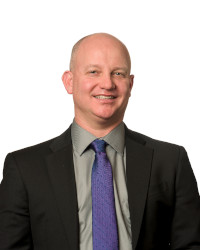
Rob Mathews, co-author, Entrepreneurship The Disney Way
“Most jobs, businesses, and projects go well when they match your passion and psychological talents. Writing is no different,” Mathews said when asked why he and his co-author selected Disney as the model company for the book. “Mike and I had great knowledge of Disney as a business model, we had friends in the company, we love the company as a consumer, and we connected with the story of Walt’s vision, perseverance, and legacy that lives on today. I would also add that the way we approach our lives and business matches up with Disney very well. We value innovation, heritage, professionalism, intentionality, attention to detail, and great leadership. Disney is an exemplary model for those principles.”
In what ways does a mission developed in the 1920s remain relevant today? “Disney’s mission is timeless,” Mathews said. “It essentially hasn’t changed since Walt’s initial vision. The company’s overall mission–essentially to be the best in entertainment–and the parks and resorts mission–basically to create happiness–have more or less remained the same. Those missions are simple, inspiring, and easy to get behind as a leader, cast member, partner, or vendor. And the customer can feel and experience the Disney difference, as we like to call it.”
When asked to share examples of Disney entrepreneurship and innovation in the past three years he said, “Most of Disney’s recent innovations that come to mind have surfaced in the theme parks. Attractions like Tron Lightcycle Power Run in Shanghai Disneyland, Avatar Flight of Passage in Animal Kingdom, Slinky Dog Dash in Hollywood Studios, and Millennium Falcon: Smuggler’s Run are truly cutting edge. The parks and lands that house those attractions, Shaghai Disneyland, Toy Story Land, Star Wars: Galaxy’s Edge, Pandora – The World of Avatar, are breathtaking innovations that remove guests from the realities of their lives. Pandora literally looks like we saw it on the movie, and the Star Wars land makes you forget that you are in a theme park. Beyond attractions and theming, less noticeable, yet highly impactful system and process innovations, such as waste management at Magic Kingdom, the most visited theme park in the world, have changed the way Disney does business.”
When asked: The Millennial generation is said to be the most diverse generation yet. In what way does the model you propose take into account Millennials, diversity among workers and customers? he replied, “Our Entrepreneurial Leadership Instrument (ELI), like most assessment tools in my belief, bridge generational gaps and provide a common language for people. These tools demonstrate the value of each person, and empower people to be themselves. For a generation that was told to behave a certain way, think very specifically, and take orders, genuine and authentic use of such tools is extremely refreshing and encouraging. Millennials appreciate that kind of approach to leadership and team building. Good assessment tools also highlight the value and critical importance of cognitive diversity, along with building diverse teams. As for customers, the ELI points to the need to speak differently to different players. Not everyone will respond to marketing, mission, branding, brand promise, etc. the same, and companies need to know that and build appropriate strategies. The days of push marketing are largely over. It’s a lot like how good teachers make sure they are addressing the various learning styles in the classroom.
The Disney Company has done an excellent job of creating a very diverse culture that welcomes and provides opportunities for all people. Millennials like working at Disney because the mission is clear, positive, and constantly supported and reinforced. Millennials are very mission-centered, so Disney’s extreme emphasis on mission and investment in people in very attractive to them.”
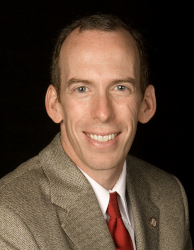
Michael Goldsby, co-author, Entrepreneurship The Disney Way
When asked about allegations of gender parity issues at Disney (see Underpaid and undervalued: 10 women claim systemic discrimination at Disney from September 18, 2019, The Guardian, theguardian.com/world/2019/sep/18/disney-lawsuit-gender-pay-gap-abc?), Mathews replied: “I can’t really speak to the media side of the company too much, as we don’t have contacts there, nor has it been our research focus. The Parks and Resorts division seems to treat all cast members extremely well, so it does not impact the concepts we shared in the book.”
Only Mathews responded to email questions. Goldsby is chief entrepreneurship officer and Stoops Distinguished professor of Entrepreneurship at Ball State University in Indiana. Mathews is the director of the Institute for Entrepreneurship and Free Enterprise at Ball State University.

Click to buy Entrepreneurship the Disney Way
Comments:
Filed Under: Books

























